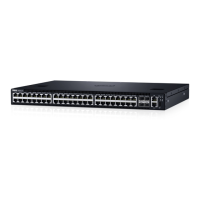• Have you enabled OSPF globally?
• Is the OSPF process active on the interface?
• Are adjacencies established correctly?
• Are the interfaces congured for Layer 3 correctly?
• Is the router in the correct area type?
• Have the routes been included in the OSPF database?
• Have the OSPF routes been included in the routing table (not just the OSPF database)?
Some useful troubleshooting commands are:
• show interfaces
• show protocols
• debug IP OSPF events and/or packets
• show neighbors
• show routes
To help troubleshoot OSPFv2, use the following commands.
• View the summary of all OSPF process IDs enables on the router.
EXEC Privilege mode
show running-config ospf
• View the summary information of the IP routes.
EXEC Privilege mode
show ip route summary
• View the summary information for the OSPF database.
EXEC Privilege mode
show ip ospf database
• View the conguration of OSPF neighbors connected to the local router.
EXEC Privilege mode
show ip ospf neighbor
• View the LSAs currently in the queue.
EXEC Privilege mode
show ip ospf timers rate-limit
• View debug messages.
EXEC Privilege mode
debug ip ospf process-id [event | packet | spf | database-timers rate-limit]
To view debug messages for a specic OSPF process ID, use the debug ip ospf process-id command.
If you do not enter a process ID, the command applies to the rst OSPF process.
To view debug messages for a specic operation, enter one of the optional keywords:
• event: view OSPF event messages.
• packet: view OSPF packet information.
• spf: view SPF information.
• database-timers rate-limit: view the LSAs currently in the queue.
560
Open Shortest Path First (OSPFv2 and OSPFv3)

